ASUS PG42UQ OLED HDR Best Settings Guide
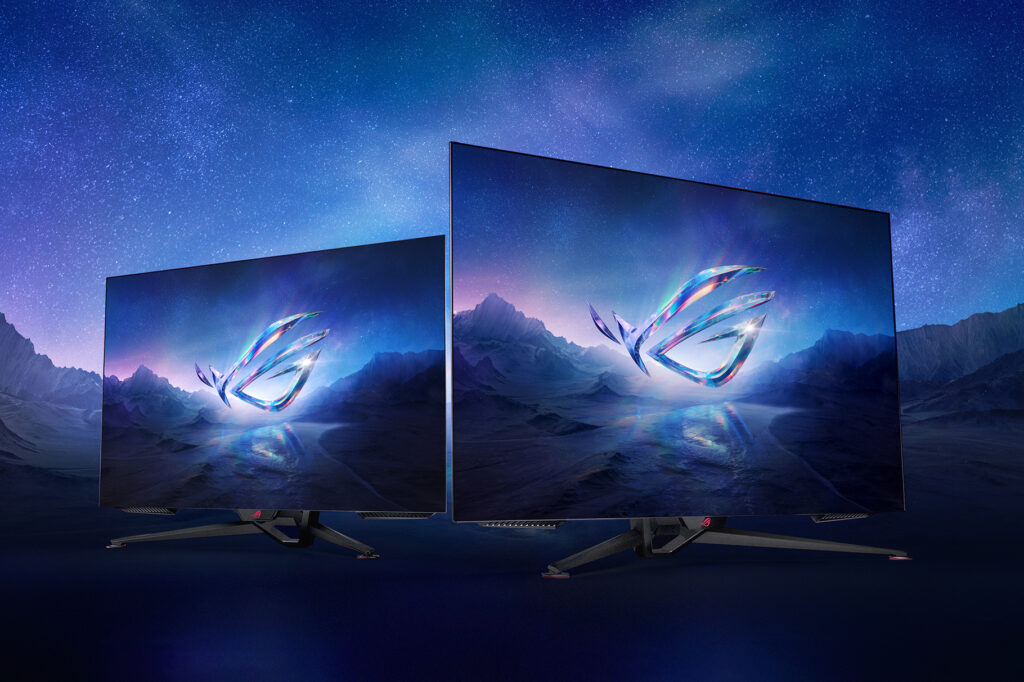
Last updated on July 13, 2023
**Please see UPDATED VERSION of this settings guide –> PG42UQ Firmware V40 HERE **
Last Updated: May 25, 2023 / Firmware Version V033 – Color Channel Values added for NVIDA Control Panel Settings for user with NVIDIA Game Driver Version 532.03 or later.
To receive updates on ROG Swift OLED PG42UQ content, please subscribe below.
Table of Contents
PLEASE READ BEFORE CONTINUING
There are two guides on this site for setting up your PG42UQ HDR settings. Which guide you use will depend on your FIRMWARE VERSION. You can check your firmware version by clicking the joystick button under your monitor to the left, then SYSTEM SETUP -> Information “FW Version”. If you have version “V033”, you are on the right page and you may continue to follow the guide below.
If you have version “V037” or want to upgrade to V037 you need to follow the instructions on the following page ASUS OLED PG42UQ V037 Firmware Best HDR Settings Guide. (*Note: The linked page will redirect you back to this guide to follow specific instructions to avoid duplicate content on this website.)
Also, please be aware, ASUS has not officially released firmware version V037 (as of 06/09/2023), the firmware was given to a Reddit user by via a link by ASUS support. We have downloaded and installed V037 on three PG42UQs with no issues. Here is the Reddit thread in case you would like to vet out the source of the V037 for yourself.
Introduction
Welcome to our HDR settings guide for the ROG Swift OLED PG42UQ. Below we shared our preferred configurations to get the most from this beautiful HDR OLED monitor. We explain how to tweak Nvidia Control Panel to optimize colors and, show you how to use Windows 10/11 display settings to optimize HDR with the Windows HDR Calibration App.
PG42UQ Firmware History
As of mid-January 2023, the latest firmware for the PG42UQ is Version 033 or V033. Previous firmware versions created problems for all PG42UQ early adopters. People using V025 and V028 complained of monitor wake-up problems, weird colors, washed out HDR and a few other issues.
Firmware V032 reportedly bricked many PG42UQs creating a fear of updating the firmware altogether. V031 was the best and most stable version before V033, which still isn’t perfect. However, we have figured out some workarounds, in the Windows 10/11 environment, to fix the minor imperfections of V033.
**Please see UPDATED VERSION of this settings guide –> PG42UQ Firmware V40 HERE **
How to Update PG42UQ Firmware
First things first. Anyone experiencing problems with their PG42UQ should install latest firmware, V033. Many of the issues people complain about are irrelevant with the new firmware. Do a quick check of your current firmware version by pushing the under-monitor stick to the left and then navigate the OSD menu to System Setup->Information->FW Version.
If you already have the latest firmware V033 and are experiencing problems, you may want to reinstall the firmware. There is a correct way to install and there is a wrong way that incorrectly installs the firmware. We have experienced the wrong way issue with 2 of 3 PG42UQ monitors we use. After reinstalling the correct way, our issues went away (with the exception to HDR color issues and very infrequent wake issues). If you experience any issues or problems after using this guide or need additional help, please lets us know in our own ASUS Forums. We are here to help out. Let’s get started.
Connect to the PG42UQ Correctly Before Updating the Firmware
There is a correct way and a wrong way to update the firmware for your PG42UQ. In both cases, the update will show the firmware version was updated. So beware, if you don’t follow the guide to installing the firmware accurately, you may get a false positive installation. Not to worry, if you mess up, you can always reinstall the firmware correctly.
The correct way to install V033 firmware, per the instructions, is to connect both your PG42UQ USB-B and HDMI-1 2.1 port to your computer. Notice we have underlined the exact ports on the PG42UQ that need to be connected. Please refer to the diagram below to make certain your monitor is connected properly.
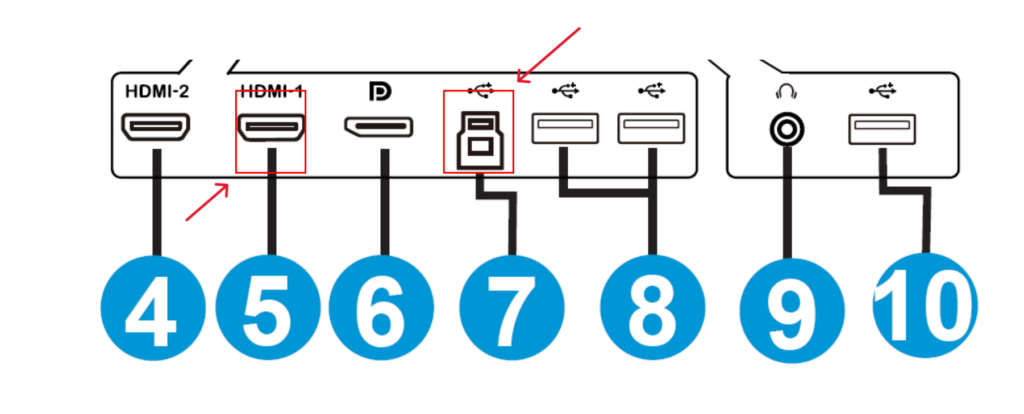
If your monitor is connected to your computer via connections other than what is shown above, disconnect them. Once you have properly connected your PG42UQ to your PC, follow the instructions below.
Steps to Update Your PG42UQ Firmware
- Step 1: Correctly Connect Your Monitor
- Disconnect all monitors connected to your PC except for the one to be updated. The firmware installation software has no options to select which monitor will receive the firmware update, so it is best to have only the target monitor connected.
- Step 2: Check Monitor Connection Configuration (VERY IMPORTANT)
- Make sure the PG42UQ is connected to the PC with the proper configuration. Make sure the monitor is connected via HDMI-1 and USB-B only. (See above)
- Step 3: Download Firmware & ASUS VLI FW Update Tool
- Go to ASUS website and click on the ‘Driver’s & Tools’ Tab.
- Choose your product and operating system in the drop-down menu.
- Scroll down to ‘Firmware’ and download the latest firmware update.
- Step 4: Install ASUS VLI FW Update Tool
- Unzip and extract the firmware package to a folder.
- Run the executable file ‘ASUS VLI FW update tool_Setup’ located in the folder and follow the prompts to install the program to Windows.
- Step 5: Run ASUS VLI FW Update Tool
- Run the ‘ASUS VLI FW Update Tool’ you just installed in Windows. Ensure the software sees your monitor. The software status should display in blue letters ‘Device Connect’.
- Step 6: Choose Firmware File for Update
- In the ASUS VLI FW Update Tool click “Open File’ and choose ‘ASUS_PG42UQ_V033.bin’ located in the same directory as the ‘ASUS VLI FW Update Tool installer’. Then click ‘FW Update’. The update takes 10-15 minutes. When finished the monitor will restart and the Updater tool will indicate ‘Device update success, please power cycle the monitor’
- Step 10: Power Cycle Monitor
- Unplug the power to the monitor for 15-30 seconds and plug it back in.
- Step 11: Reset PG42UQ Settings
- Use the OSD menu, by pushing the joystick under the monitor to the Left. ‘System Setup->All Reset->Yes’
- Step 12: Check Firmware Version
- Check the firmware has been updated via the OSD menu. ‘System Setup->Information’. It should read ‘FW Version V033’.
Congratulations! You have correctly updated the firmware for your PG42UQ OLED. Now it it’s time to make the necessary tweaks to dial in the colors and HDR for your monitor. If you were unable to install the firmware and ran into issues, please let us know in our own Asus Forums. We would be happy to help you troubleshoot.
PG42UQ HDR Fix and Adjustments
Making your PG42UQ work well in the Windows environment takes a few minor adjustments. Please note, the following adjustments are based on V033 firmware, any other versions of firmware may not work well with the following settings.
First things first, update the firmware to V033. The steps on how to install PG42UQ firmware are above. Secondly, you need to make sure Windows is using the latest ASUS PG42UQ Display Drivers. Windows will NOT automatically use the ASUS drivers as far as we know, so it’s important to download them from the ASUS website and install them manually.
Install PG42UQ Drivers for Windows
- Step 1: Download
- Go to ASUS website and click on the ‘Driver’s & Tools’ Tab.
- Choose your product and operating system in the drop-down menu.
- Driver Package->’ASUS_PG42UQ_WHQL_Driver’->Download
- Extract the Zip file into a folder.
- Step 2: Install Driver
- In Windows Start Menu->Search: Display Settings. Scroll down and choose Advanced display.
- Click on ‘Display adapter properties for Display(X)
- In Properties Window click on ->’Monitor’ (Tab)->Properties->Driver (Tab)->Update Driver->’Browse my computer for drivers’. Select the folder where you extracted the driver files. Then click ‘Next’
- Close all windows
And you are done! Windows is now using the official drivers ASUS created for the PG42UQ OLED. If you experience any issues trying to install the driver, lets us know in our Asus Forums.
Onward to the next steps to dial your ROG Swift OLED PG42UQ. You are almost done!
Windows Display Setting HDR Tweak
- Step 1: Open Display Settings & Turn On HDR
- Windows Start->Search: Display Settings->Select Display (PG42UQ)
- Scroll Down->HDR->Turn On
- Click HDR Menu Bar->Scroll down->Auto HDR->On
- SDR content Brightness->Set to ’75’
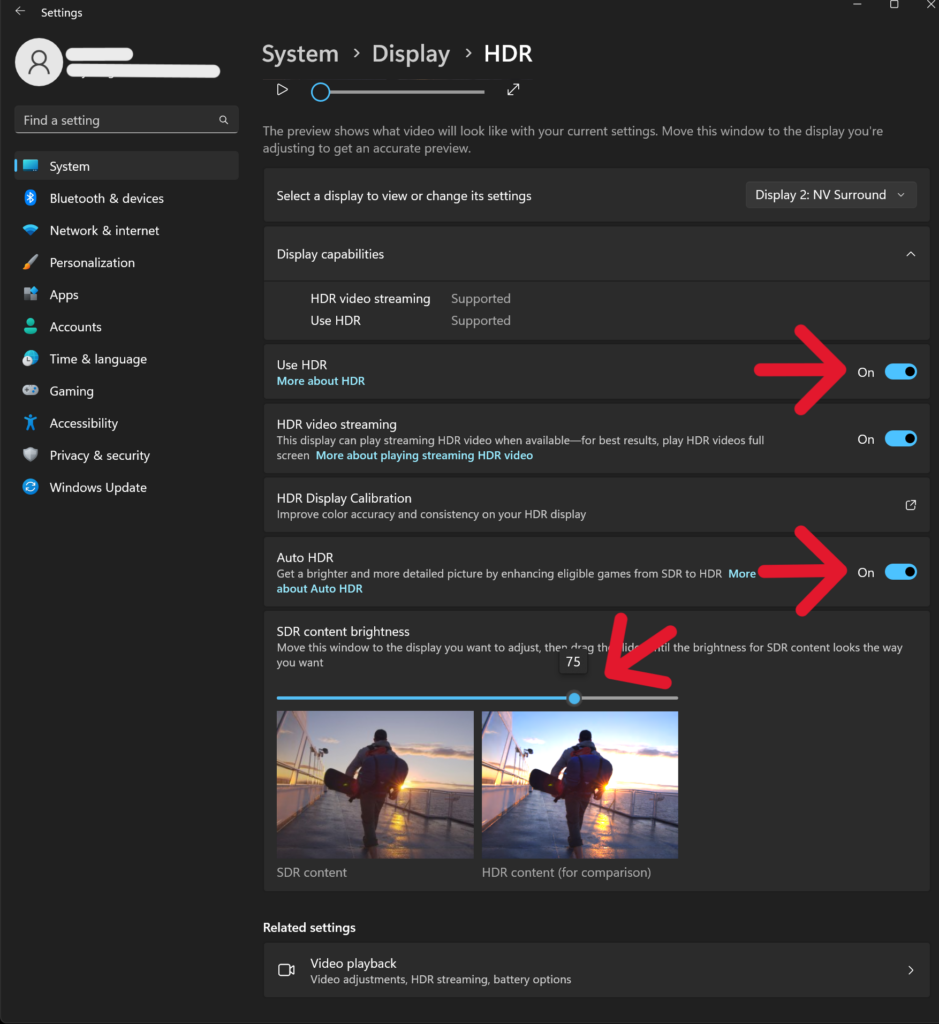
**Please see UPDATED VERSION of this settings guide –> PG42UQ Firmware V40 HERE **
Configure the Following Settings in NVIDIA Control Panel
- Step 1: Open NVIDIA Control Panel (***IMPORTANT NOTICE***: If you are using NVIDIA Game Drivers 532.03 or later, use the values in bold & parentheses, instead of the values in the picture depicted and normally typed.)
- Open NVIDIA Control Panel and navigate to Display->Adjust desktop color settings
- Select the display you would like to change. (Note: The example below is using NVIDIA Surround for 3 PG42UQs)
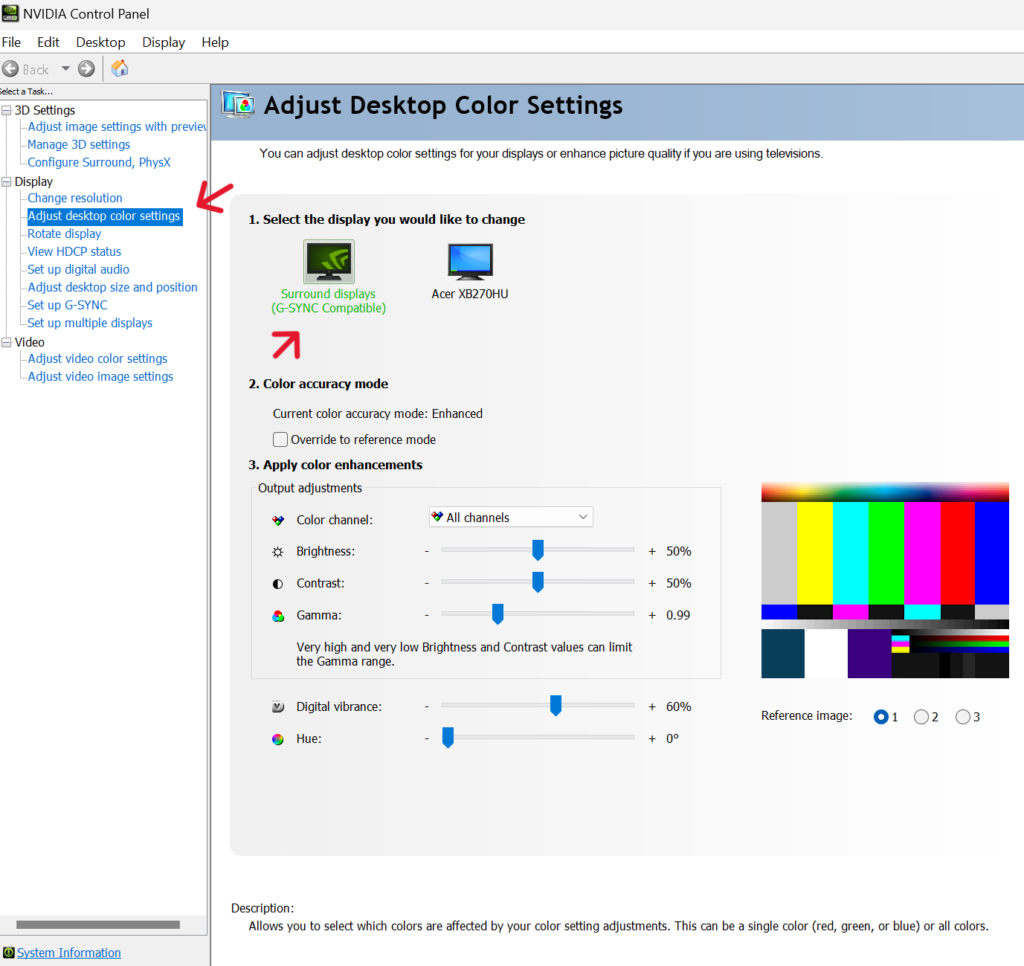
To receive updates on ROG Swift OLED PG42UQ content, please subscribe below.
- Step 2: Adjust Digital Vibrance
- Adjust Digital vibrance to 60% (NVIDIA Drivers => 532.03 =77% to 83%). NOTE: You can adjust this setting AFTER completing ALL the steps in this guide; in case the colors are too vibrant or are still washed out. In our case, 60% is the sweet spot for three PG42UQs.
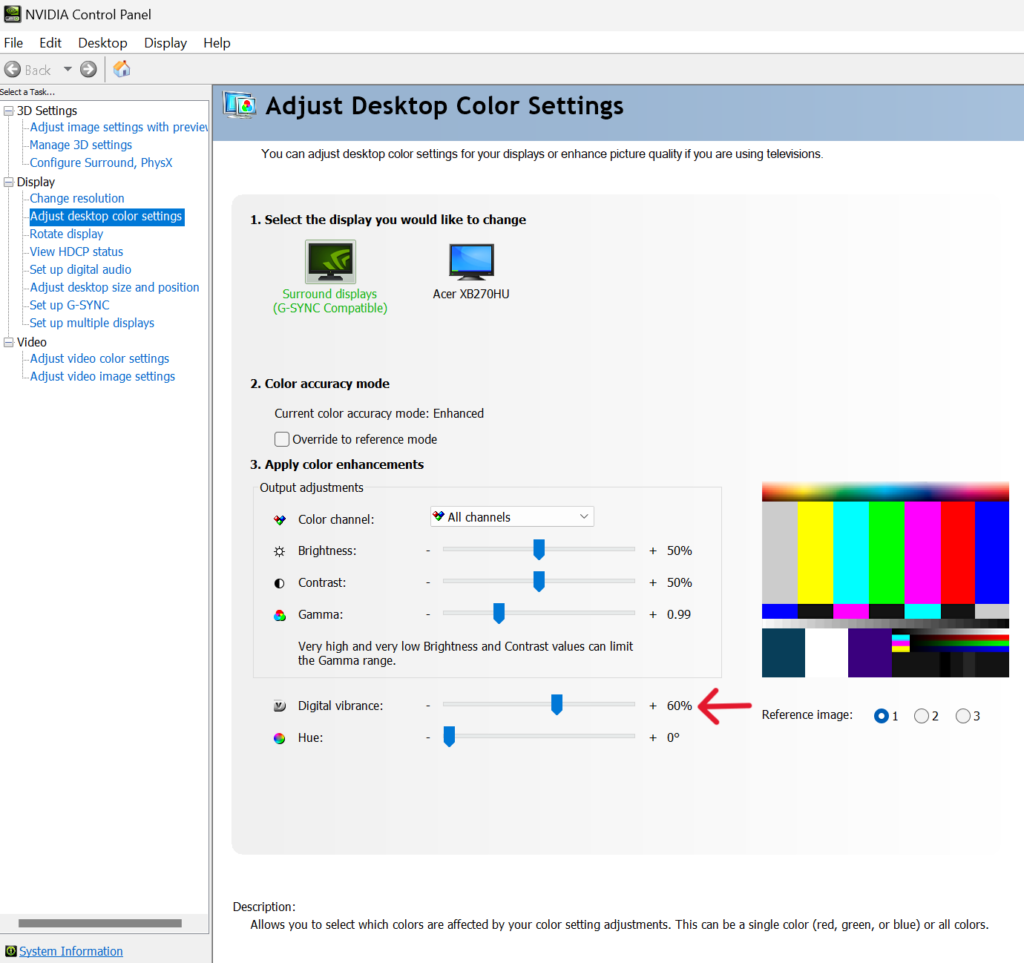
- Step 3: Adjust ‘Red’ Channel
- Change the Color channel to ‘Red’ using the drop-down menu
- Decrease Red gamma to 0.95 (NVIDIA Drivers => 532.03 – Gamma = 1.00, Brightness = 47%, Contrast = 50%)
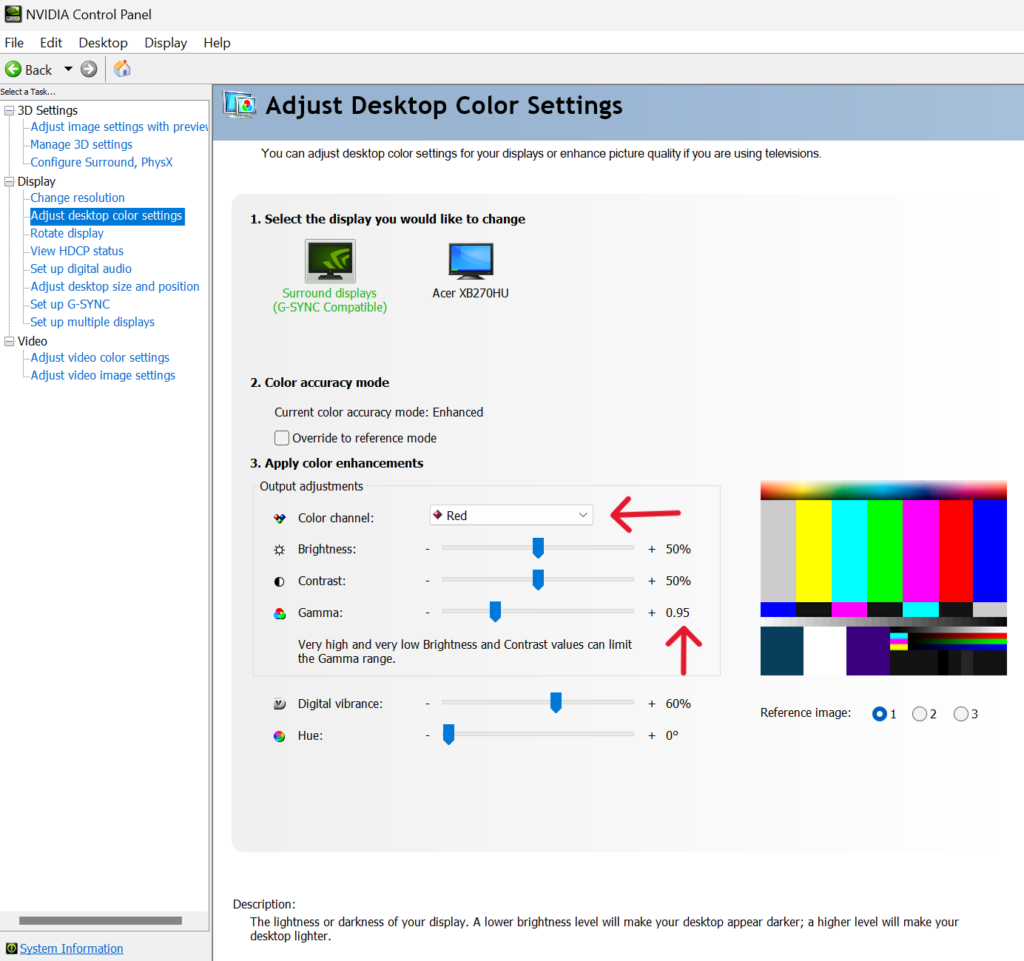
- Step 4: Adjust ‘Green’ Channel
- Change the Color channel to ‘Green’ using the drop-down menu
- Increase ‘Green’ Gamma to 1.01 (NVIDIA Drivers => 532.03 – Gamma = 1.01, Brightness = 47%, Contrast = 50%)
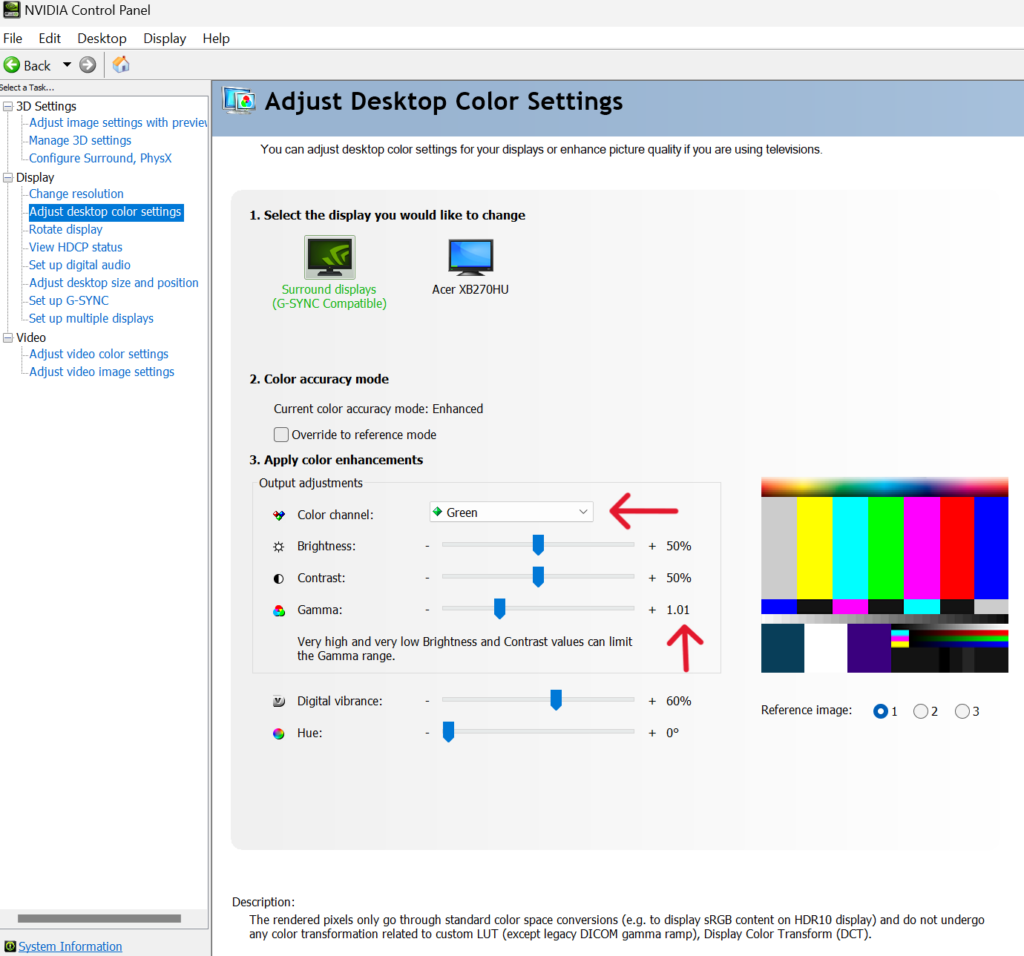
- Step 5: Adjust ‘Blue’ Channel
- Change the Color channel to ‘Blue’ using the drop-down menu
- Increase ‘Blue’ gamma to 1.01 (NVIDIA Drivers => 532.03 – Gamma = 1.01, Brightness = 52%, Contrast = 50%)
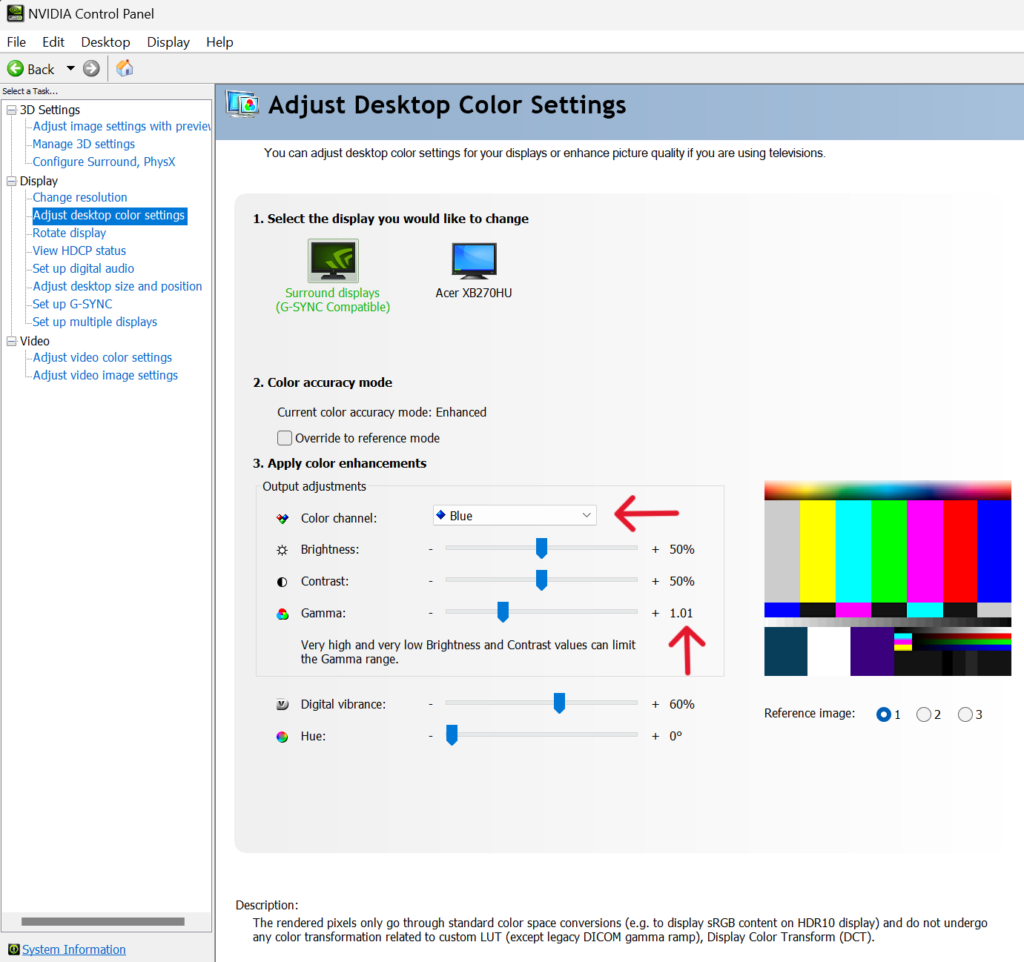
You are done with the Nvidia Control Panel adjustments. You just need to wrap things up with the Windows HDR Calibration App and you will be computing and gaming in HDR OLED heaven in no time.
Windows HDR Calibration App Install and Calibrate
- Step 1: Download and Install Windows HDR Calibration APP
- Start Menu-> Search: Microsoft Store
- Microsoft Store Window->Search->Windows HDR Calibration App->Get
- Step 2: Run The Windows HDR Calibration App
- Before you run the app, make sure HDR is turned on in Display settings->HDR. Follow the app instructions.
Adjust Nvidia Control Panel “All Channel-Brightness & Contrast” to Taste
After completing all the steps above, you can increase the vividness of your PG42UQ by adjusting ALL CHANNELS brightness and contrast in the NVIDIA Control Panel (Display->Adjust desktop color settings). Make sure you have selected the correct display AND you are adjusting ALL CHANNELS.
Begin with adjusting the brightness and then follow-up with contrast correction. Our preferred settings for brightness & contrast are 57% and 67%, respectively.
**Please see UPDATED VERSION of this settings guide –> PG42UQ Firmware V40 HERE **
Ongoing Issues & PG42UQ Forum
Since the latest firmware version, V037, failed to bring a “new day” for PG42UQ owners, we are going to need a place to get updates for PG42UQ settings when NVIDIA drivers release, ASUS drops new firmware and other related updates. We have created a forum to keep all these issues in one easy place, ROG SWIFT OLED PG42UQ Forum. You will need to sign up for a free account with WiredColony and sign up for the newsletter below. We will send you updates on all things pertaining to the PG42UQ and best of all, we will notify you as soon we get any updates.
Conclusion
Well, that concludes this tutorial on the best settings for the ROG Swift OLED PG42UQ. We hope our settings worked as well for you as it did for us. If for some reason you are not getting results you wanted, let us know in by posting a topic in the PG42UQ Forum. We would be happy to help you figure things out. Also lets us know how this guide was helpful in the comments below. Happy gaming and computing!
To receive updates on ROG Swift OLED PG42UQ content, please subscribe below.
Need more help? Join our community today to visit our forums! Sign up for a free WiredColony Account.






Thank you for your steps, this truly saved my hdr experience, it looks great now.
Awesome, happy it helped you out!
Is there a way to create a profile for the Nvidia changes such that they only engage in HDR? Manually switching profile would be ok too. Or are you using these same settings for SDR?
Cheers! And thanks for the guide 🙂
-Paul
Hi Paul,
Glad it helped you out. As far as a profile switching in NVIDIA, I haven’t seen anything. If you find HDR in Windows isn’t looking as nice as SDR, try switching your wallpaper/background to an HDR image. I leave HDR on at all times with the settings above with no issues whatsoever.
Thank you for the instruction. That’s very helpful.
Can you share your settings for the monitor side.
Absolutely, my settings are:
-HDR Mode = ASUS Gaming HDR
-Overclocking = Off
-Adaptive-Sync = On
-Aspect Control = Full
-Power Setting = Standard Mode
-Screen Saver = On
-DisplayPort Stream = 1.4
-DSC Support = On
-HDMI CEC = On (However I don’t use HDMI on any of the three monitors)
-Color Depth 10bps
-Format RGB 444
-Range Full Range
-VRR Supported
-FW Version V033
What about game visual mode? It’s race mode by default.
“GameVisual” Menu is greyed out, so I am assuming it doesn’t apply when in HDR mode. I am always in HDR mode. I don’t switch between SDR and HDR.
Thank you for this great tutorial.
The new firmware is confirmed to come later this month to fix the HDR issue.
So I am a not sure if i should finish your tutorial while waiting as I am afraid to not be able to put everything back to how it was to check to actual effectiveness of the new firmware.
Any advices by any chance?
Also playing with digital vibrance doesnt normally affect the original quality of your image?
Thanks in advance for the help !
@stevewind ASUS says they are going to release new firmware but, I am not betting on it. Their commitment to quality has tanked. The prominent techies on youtube, @jaytwocents, @LinusTechTips, etc., have videos regarding ASUS’s lack of commitment to quality.
As far as going back to default settings, it isn’t difficult. All you have to do is set all color channels to 50%, all gamma channels to 1.0 and digital vibrance to 50%. I will do a tutorial for the new firmware, if and when it comes out.
I see thank you.
I also play on ps5 with this screen, so except a miracle with the next firmware, i will still have washed out HDR on my console?
Thanks again for your time and reply !
@stevewind I don’t have any experience with PS5. I did find videos on Youtube about HDR adjustments. Try out this the ideas on this video https://www.youtube.com/watch?v=lugHzr1GZEI.
Hi teedog,
It actually help quite a bit for the ps5 ! Thanks for that, but still not as good as the HDR from a C2.
I also did all your tutorial for windows and thansk a lot as it much better BUT still I feel something is off as its still dont compare with a C2.
One thing to note is that I have still have windows 10 and the HDR calibration APP is not available from the store for me, its only for Window 11. So how crucial is this step of your tutorial if i may ask?
Do you think i should try to go to V28 to see if the HDR fits better my needs?
I am still very very dissapointed with the HDR for this screen when i compare with the C2 which is so beautiful AND much cheaper.
Also I still can return it for “free” to Amazon until the 10th of June, but im afraid of worse case scenario: damage during transport that could lead to 1/ loosing the refund and 2/ getting back a damaged screen.
So I am waiting for the new firmware with a lot of hope until the 5th of June before taking my decision, so I thought maybe going back to V28 could be a wise move? What do you think?
Thanks again for all your advices and article, you rock!
@stevewind For some reason, there was no reply button to your message below so I am writing it here.
1. C2 vs Pg42UQ – I have said this before when asked, unless you have a triple screen setup or aspire to have one in the future, go for the C1/2/3. The reason you would go for the PG42UQ is for the three DisplayPorts. PC GPUs, as far as I know, only support DisplayPort for triple screen setups with HDR. If you use an adapter to convert the DP to HDMI, you lose VRR and HDR.
2. V028 PG42UQ Firmware – I think V033 is the best firmware, although when I used V028, I didn’t have to color correct for HDR. Personally, I would stick with V033 and see what happens with the next update. And of course, if you are only using one screen, I suggest the C2 or C3.
3. I do believe the C2 and PG42UQ will look different since the they have different coatings on the screen. LGs are glossy and ASUS are matte. I do think the effect is different when viewing and is a personal preference. I do like glossy but I don’t like the reflections. Matte give me more of a feel of a “reaching inside the screen to touch” feeling. Glossy is more like eye-candy.
4. Lastly, HDR is meant to make things look more realistic, as opposed to vividness and colorful. So, grass should look like real green with lots of variations of green, not eye-candy vibrant green. Colors using HDR in my experience just have a real look to them, something a glossy screen doesn’t help IMO.
Hope this is helpful…let me know if you have any more questions! Happy to help!
Thanks for your help !
Just one thing you didnt confirm me if the HDR calibration app from win 11 makes a big difference or not with your tutorial?
The glossy screen is not my preference, i simply compare in pure image quality for gaming with HDR on. My friend have it and its day and night.
Also your tutorial helps a lot but i can obviously see a bit of loss in image quality when i compare to Nvidia/Windows setting by default in SDR. Certainly due to the digital vibrance higher.
I will try V28 to see with my own eyes, especially as you tutorial is for windows and not ps5. I think i may have better HDR in my PS5 with V28.
If ever its not good enough i will revert to v33 while waiting the new update. But if they are late on delivery for this I will have no choice but to try get my refund from amazon and go for a C2 or C3.
What a let down this screen is so far, i save money for a long time to choose a OLED screen for my Bday and all i get if issues, unertainity and dissapointement.
@stevewind I do believe the Windows Calibration app makes a noticeable difference. I definitely suggest upgrading to Windows 11. There are Windows 11 install workarounds if your system doesn’t fit the specs.
As far as HDR vs SDR, there should be a noticeable difference. SDR content may not looks so good in HDR but, HDR will blow away HDR content SDR. So how something looks in HDR depends on whether the content is HDR optimized.